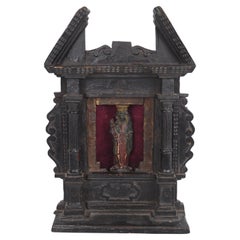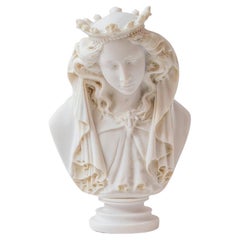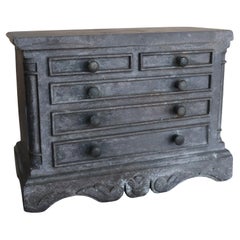Dullaert Art & Antiques Folk
to
1
1
1
1
1
1
1
Miniature Altar with Mother Mary with infant Jezus in Renaissance style, 1657
Located in Gorssel, GE
Wooden miniature altar with Mother Mary with infant Jezus in Renaissance style.
This altar - used for private devotion - was made in the 17th century a...
Category
Antique 17th Century Renaissance Sculptures and Carvings
Materials
Wood
Related Items
The Virgin Mary Bust, 'Virgin Mary House' Replica Compressed Marble Powder No:1
By LAGU
Located in İSTANBUL, TR
This sculpture depicts the Virgin Mary, who is known as the mother of Jesus in Christian mythology. Weighing 1.5 kg, this sculpture is produced from pressed marble powder and made using the original molds from the museum. It can be used both indoors and outdoors.
This work of art holds a special place for those interested in Christian art. The original depiction of the Virgin Mary makes it an excellent choice for art enthusiasts and collectors. Thanks to the high-quality material used in its production and the quality craftsmanship, it provides durability for many years. It can be used as a wonderful decorative piece in your garden, home, or office since it is suitable for both indoor and outdoor use. This Virgin Mary sculpture...
Category
2010s Turkish Classical Greek Busts
Materials
Statuary Marble
H 6.7 in W 4.34 in D 2.76 in
Antique Carved Slate Miniature Chest of Drawers. Welsh, Late 19th Century
Located in St Annes, Lancashire
A charming miniature chest of drawers made from carved slate
With dummy drawers and Prince of Wales feathers detail.
Miniature chests, bureaus and similar pieces of folk art were c...
Category
Antique Late 19th Century Welsh Folk Art Sculptures and Carvings
Materials
Slate
The Virgin Mary Bust, 'Virgin Mary House' Replica Compressed Marble Powder No:2
By LAGU
Located in İSTANBUL, TR
This sculpture depicts the Virgin Mary, who is known as the mother of Jesus in Christian mythology. Weighing 1.5 kg, this sculpture is produced from pressed marble powder and made us...
Category
2010s Turkish Folk Art Busts
Materials
Statuary Marble
H 8.67 in W 5.91 in D 3.35 in
18th/19th Century Spanish Colonial Carved Polychrome Wood Santo Altar Sculpture
Located in Forney, TX
A most impressive antique Spanish Colonial hand carved polychromed wood Santo Catholic church altar figure. circa 1800
Hand-crafted in the late 18th / early 19th century, exceptionally executed intricate detailing, the large scale antique religious sculpture depicting the female Saint Teresa of Avila, polychrome painted gesso over finely sculpted wood, inset glass eyes, shown in Carmelite nun habit...
Category
Antique Late 18th Century Spanish Colonial Sculptures and Carvings
Materials
Gesso, Wood, Paint
H 19.5 in W 7.75 in D 7.5 in
Miniature Dogon Ladder: A Path to Personal Growth and Spiritual Enlightenment
Located in Stockholm, SE
Symbolically, miniature ladders like the Dogon ladder can hold various meanings depending on the context in which they are used and their cultural or historical background. For example, a miniature ladder can be a metaphor for ambition and personal growth, representing the desire to reach new heights or overcome obstacles. In spiritual contexts, a ladder can symbolize a path to wisdom or enlightenment, reflecting a personal quest to achieve higher consciousness or insight.
The interpretation of its design is multifaceted and may reflect a combination of traditional, cultural, and personal values. It serves as a beautiful symbol for those seeking inner guidance, a personal altar...
Category
Vintage 1940s Malian Folk Art Sculptures and Carvings
Materials
Hardwood
Mother Mary Madonna Wood Carved Polychrome Santo Santos, 18th-19th Century
Located in Studio City, CA
A beautiful hand-carved wood Santo of the Madonna, Mary mother of Christ.
The piece clearly shows signs of weathering, use, and age and was likely placed outside a church or shri...
Category
Antique 19th Century Primitive Sculptures and Carvings
Materials
Metal
The Snaked Altar Column Statue Compressed Marble Powder Sculpture Bergama Museum
By LAGU
Located in İSTANBUL, TR
Weight: 8 kg
The Snaked Altar, situated atop a marble column at the entrance square of the Ancient City of Asclepion, holds the distinction of being recognized as the earliest symbol of medicine and pharmacy.
The altar's prominent position within the Asclepion complex highlights its importance in the context of ancient medical practices. It served as a visual representation of the profound connection between spirituality and healing, as Asclepius, the Greek god of medicine, was often depicted alongside snakes, which were regarded as symbols of rebirth and rejuvenation.
Today, the original Snaked Altar finds its rightful place of honor in the prestigious Bergama Museum. Visitors to the museum can marvel at its intricate details and appreciate the craftsmanship of the ancient artisans who sculpted it. The altar's preservation allows us to delve into the depths of history and gain insights into the ancient world's understanding and reverence for medicine.
*Crafted from compressed marble powder.
*Manufactured using molds...
Category
21st Century and Contemporary Turkish Classical Greek Sculptures and Car...
Materials
Statuary Marble
H 11.23 in W 5.71 in D 5.71 in
circa 1900 Miniature Model of a Black Forest Bear Bench
Located in Chicago, IL
circa 1900 Miniature Model of Black Forest Bear Bench. "Black Forest" is a term to describe elaborate, realistic wood carvings from an area in ...
Category
Early 20th Century German Black Forest Animal Sculptures
Materials
Walnut
18th/19th Century Italian Baroque Silvered Metal Altar Monstrance Reliquary
Located in Forney, TX
A stunning antique Italian Baroque style silvered metal gilded wood monstrance reliquary. circa 1770-1820
Handmade in Italy in the late 18th / early 19th century, commissioned by the church to display an important religious relic, sculptural painted wood form, mounted with decorative silver repousse metal facing, open oval window where the philatory relic was once housed, rising on a gold gilt painted shaped plinth base.
Dimensions: (approx)
17" High, 8" Wide, 5" Deep, 1.25lbs
History:
Reliquaries (also referred to as a shrine or châsse in French), are containers used to protect and display relics. A portable reliquary may be called a fereter, and a chapel in which it is housed a feretory. A monstrance, also known as an ostensorium (or an ostensory), is a vessel used in Roman Catholic, Old Catholic, High Church Lutheran and Anglican churches for the display on an altar of some object of piety, such as the consecrated Eucharistic host during Eucharistic adoration or Benediction of the Blessed Sacrament. It is also used as reliquary for the public display of relics of some saints.
The use of reliquaries became an important part of Christian practices from at least the 4th century, initially in the Eastern Churches, which adopted the practice of moving and dividing the bodies of saints much earlier than the West, probably in part because the new capital of Constantinople, unlike Rome, lacked buried saints. Relics are venerated in the Oriental Orthodox, Eastern Orthodox, Roman Catholic and some Anglican Churches. Reliquaries provide a means of protecting and displaying relics. While frequently taking the form of caskets, they range in size from simple pendants or rings to very elaborate ossuaries.
The relics were enshrined in containers crafted of or covered with gold, silver, gems, and enamel. These objects constituted a important form of artistic production across Europe and Byzantium throughout the Middle Ages.
Many were designed with portability in mind, often being exhibited in public or carried in procession on the saint's feast day or on other holy days. Pilgrimages often centered on the veneration of relics. The faithful often venerate relics by bowing before the reliquary or kissing it; those churches which observe the veneration of relics distinguish between the honor given to the saints and the worship that is due to God alone.
Sixteenth-century reformers such as Martin Luther opposed the use of relics since many had no proof of historical authenticity and objected to a cult of saints. Many reliquaries, particularly in northern Europe, were destroyed by Calvinists or Calvinist sympathizers during the Reformation...
Category
Antique Early 19th Century Italian Baroque Sculptures and Carvings
Materials
Metal
Mary Ellen Toya Story Teller Jemez
By Mary Ellen Toya
Located in Philadelphia, PA
Mary Ellen Toya Story Teller Jemez Mexico 7.25" tall with 11 babies. Singing Mother Motif, Singing Traditional Cochiti Songs. Am listing many American Ind...
Category
Vintage 1980s American Anglo-Indian Native American Objects
Materials
Ceramic
Hand Carved Wooden Mother and Child Statue
Located in Redding, CT
Hand carved wooden mother and child statue. Or Madonna and child. Mid Century modernist in style. Nice rich wood patina with intricate craftsme...
Category
Vintage 1960s Mid-Century Modern Figurative Sculptures
Materials
Walnut
Renaissance Carved French Oak Panel
Located in Denton, TX
Weathered Renaissance carved oak panel, originally from a piece of furniture.
Category
Antique 17th Century European Renaissance Architectural Elements
Materials
Wood


